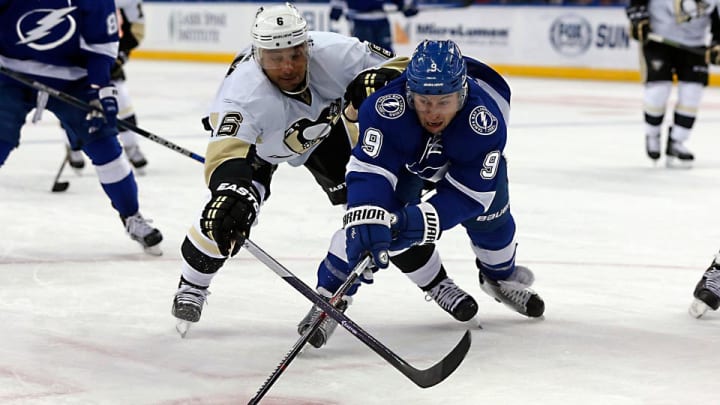NHL playoffs: Analytics predict Penguins-Lightning Eastern final

Get all of the Department of Hockey Analytics' columns as soon as they’re published. Download the new Sports Illustrated app (iOS or Android) and personalize your experience by following your favorite teams and SI writers.
As per time-honored custom, the good folks at the Department of Hockey Analytics have pulled out their abacus, crunched their numbers, and taken a hard look into the future of the 2016 Eastern Conference Finals series between the Tampa Bay Lightning and the Pittsburgh Penguins.
And now without further fuss or ado, Ian Cooper, IJay Palansky and the good Dr. Phil Curry unveil what the mystical digits tell them:
PREDICTION: Penguins (59.1%)
“Are you not entertained!?” Maximus (a/k/a Gladiator) had nothing on the series between the Penguins and Capitals—probably the best two teams in hockey, and one of the best series we can remember. If you don’t like unrivaled skill, relentless forechecking, long stretches of sustained pressure, almost inconceivable momentum swings, ridiculous goaltending, and delay of game penalties that come in threes at critical junctures of series-deciding games, then the Eastern Conference semi-final was not for you.
Washington Capitals: Much promise despite epic playoff fail
If you love hockey, it was everything the game is supposed to be.
With the Penguins and Lightning advancing, that puts the Department of Hockey Analytics’ playoff model’s prediction record for the Eastern Conference at five up and one down, with the only series we got “wrong” being the Islanders’ win over the Panthers, in which we favored the Panthers by a mere 50.9%.
Add on the fact that the Phil Kessel trade we called for at the 2015 trade deadline and putting him on the third line with Nick Bonino, which we were begging the Penguins to do way back in November has resulted in what many are calling the best line in hockey right now, and well, as you might guess, we’re feeling pretty giddy with how things are playing out.
Before the playoffs started, we predicted that the winner of the expected second round Penguins-Capitals series would be the Stanley Cup favorite. Nothing has changed that forecast.
Tampa Bay’s relatively easy dispatch of the Red Wings and then the Islanders have some pundits predicting that the Lightning will give the Penguins all they can handle. But don’t be fooled by the Tampa's two straight five-game series wins. The accomplishment of beating Detroit and Brooklyn isn’t in the same universe as the Penguins’ convincing win over the Presidents' Trophy-winning Capitals.
To give some perspective, our model predicted that the Penguins would have been an overwhelming 78.3% favorite over Detroit and a solid 66.5% favorite over the Islanders. Credit to the Lightning for taking care of business, especially with two of their best players—Steven Stamkos (blood clot) and Anton Stralman (broken leg)—sidelined, but they’re going to have to take their game to an altogether different level to have any chance against the powerhouse Penguins.
The regular season stats on which our model relies tell the same story.
The Penguins lead in almost every single category. The teams were tied in the goalie metric xSv%, but keep in mind that rookie Matt Murray didn’t get into many regular season games. So if his stellar play continues, as shocking as it sounds you might give the Penguins the edge in goaltending. Plus the Pens picked up more points (+7) in standings, more points in the second half (+6), and more points in the last 10 games (+6). Pittsburgh also had a better powerplay (+2.6%), a better penalty kill (+0.4%), and a “DOHA luck score” (which roughly measures how lucky a team was during the regular season) that suggests the Penguins’ (48-26-8) record probably should have been even better than it was, but the team floundered until coach Mike Johnston was fired.
The Penguins also dominated in the primary possession metric in our model, ESVA Fenwick, with a 53.5% to 52.3% advantage. Same for high danger scoring chances, where Pittsburgh had a massive +122 relative to the Lightning, which works out to +1.49 per game.
Penguins vs. Lightning 2016 Eastern Conference Finals preview
If anything, the Penguins are probably even bigger favorites than our model suggests because, as we pointed out before the second round, they have been a juggernaut since Mike Sullivan took over on December 12. Since then, their ESVA Fenwick was 56.0%, or 2.5 points higher than their season average, and good for second in the league. By contrast, the Lightning were tenth in the league at a respectable 52.2%, for a difference between the two teams of 3.8%. To put that in perspective, that’s the same difference between Tampa Bay and the last-place Toronto Maple Leafs over the same time period.
Plus, Tampa Bay’s stats measured the play of the team that for the most part included Stamkos and Stralman, neither of whom have yet played in the playoffs. Stralman will likely be back soon, but Stamkos remains on blood thinners and will be gone for at least the first couple of games, and likely more.
Parity rules in the modern NHL, Tampa is a good team, and goaltending can always steal a series, especially with a goalie as good (and as underrated) as Ben Bishop. But there should be little doubt that the smart money is on the Penguins to advance to the Stanley Cup Final.
The Department of Hockey Analytics employs advanced statistical methods and innovative approaches to better understand the game of hockey. Its three founders are Ian Cooper (@Ian_doha), a lawyer, former player agent and Wharton Business School graduate; Dr. Phil Curry (@Phil_Doha), a professor of economics at the University of Waterloo; and IJay Palansky (@IJay_doha), a partner at the law firm of Armstrong Teasdale, former high-stakes professional poker player, and Harvard Law School graduate. Please visit us online at www.depthockeyanalytics.com.
